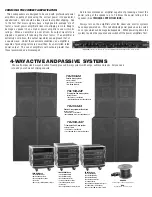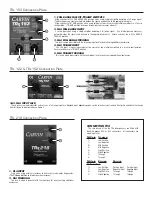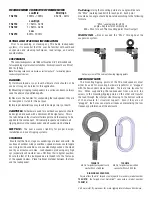
1
2
3
4
5
2
1
Full Range mode
Biamp mode
1
2
1. NL4 INPUT
Used when using external crossover to deliver only subwoofer frequencies.
(TRx218
does not
have an internal passive crossover).
2. NL4 THROUGH
This jack is wired in parrallel with the input jack for daisy chaining additional
enclosures.
1. FULL RANGE PASSIVE/TRIAMP SWITCHES
Slide switches to FULL RANGE PASSIVE position when using a single amplifier delivering a full range signal.
(The internal passive crossover network divides the signals and delivers to the appropriate drivers.)
Slide switches to TRI AMP position when using external active crossover and multiple amplifiers in a tri amp
configuration. (TRI AMP position bypasses internal passive crossover network.)
2. NL4 FULL RANGE INPUT
Use this input when using a single amplifier delivering a full range signal. (The internal passive crossover
network divides the signals and delivers to the appropriate drivers). Ensure switches are in FULL RANGE
PASSIVE position.
3. NL4 FULL RANGE THROUGH
This jack is wired in parrallel with the full range input jack for daisy chaining additional enclosures.
4. NL8 TRIAMP INPUT
Use this input when using external active crossover and multiple amplifiers in a tri amp configuration.
Ensure switches are in TRI AMP position.
5. NL8 TRIAMP THROUGH
This jack is wired in parrallel with the tri amp input jack for daisy chaining additional enclosures.
1&2. NL4 INPUT JACK
These jacks are wired in parallel and serve as a full range input or a biamped input depending upon switch selection (must remove front grille and woofer to change
from full range to biamp mode, see figure C.
TRx 153 Connection Plate
TRx 122 & TRx 152 Connection Plate
TRx 218 Connection Plate
CONNECTING TRX
The rear panels of the the TRx loudspeakers are fitted with
Neutrik Speakon NL8 or NL4 connectors. All connectors are
wired in parallel.
NL8 pin
Tri-amp
1+
Low Positive
1–
Low Negative
2+
Mid Positive
2–
Mid Negative
3+
High Positive
3-
High Negative
4+
Through
4–
Through
NL4 pin
Bi-amp
Passive
Subwoofers
1+
Low Positive
Positive Input
Positive Input
1–
Low Negative
Negative Input
Negative Input
2+
High Positive
Through
Through
2–
High Negative
Through
Through






















